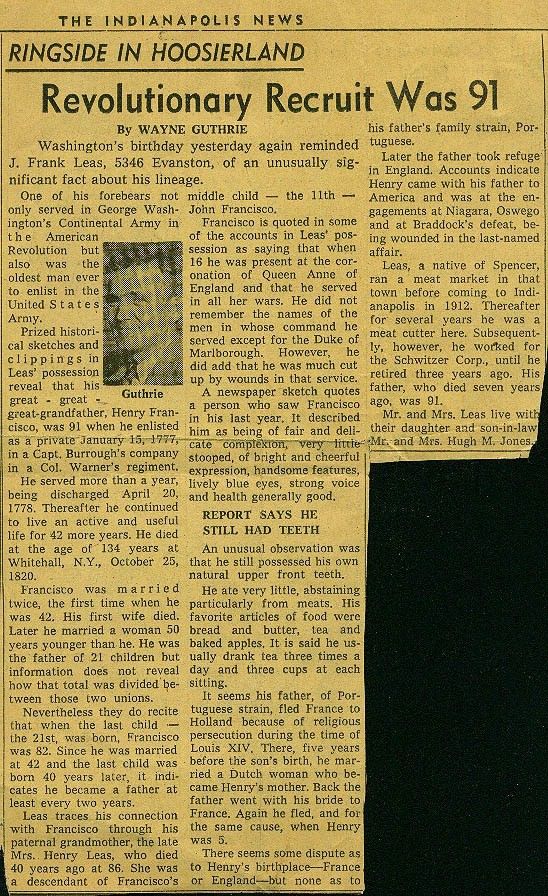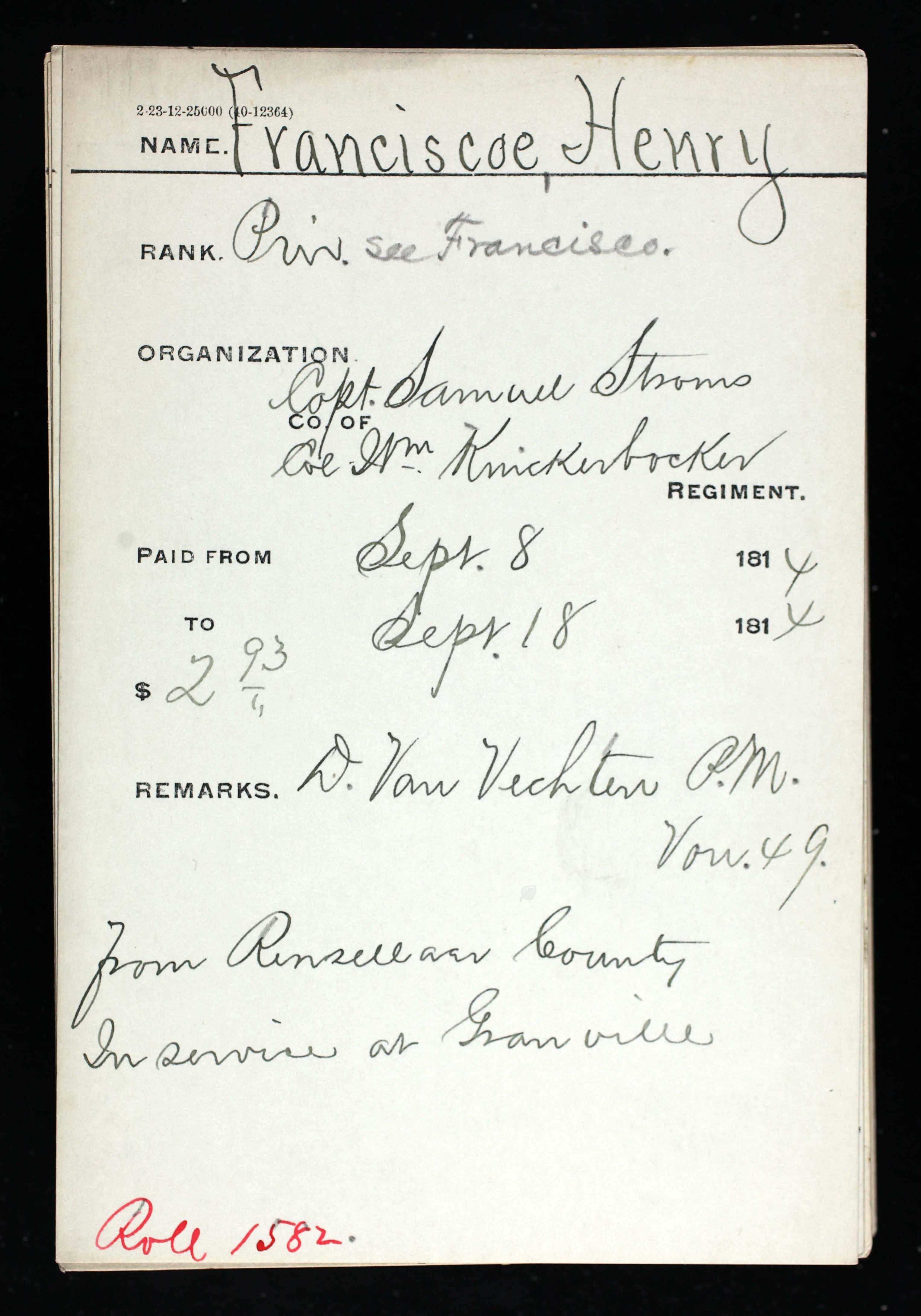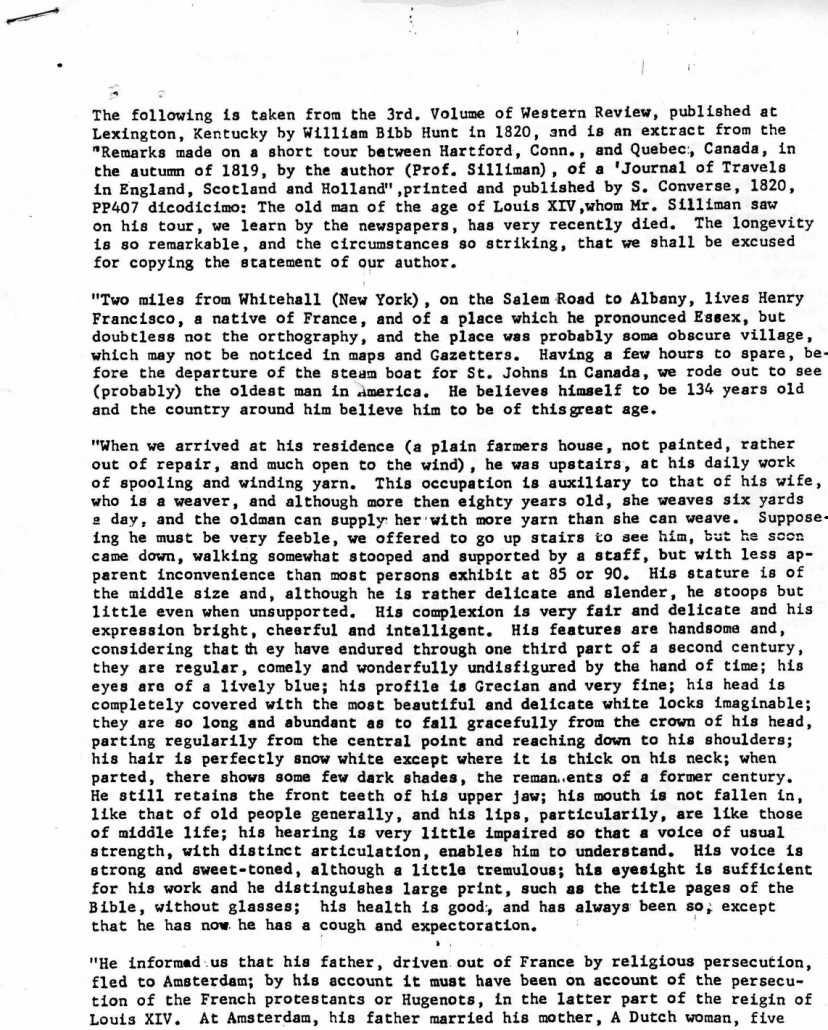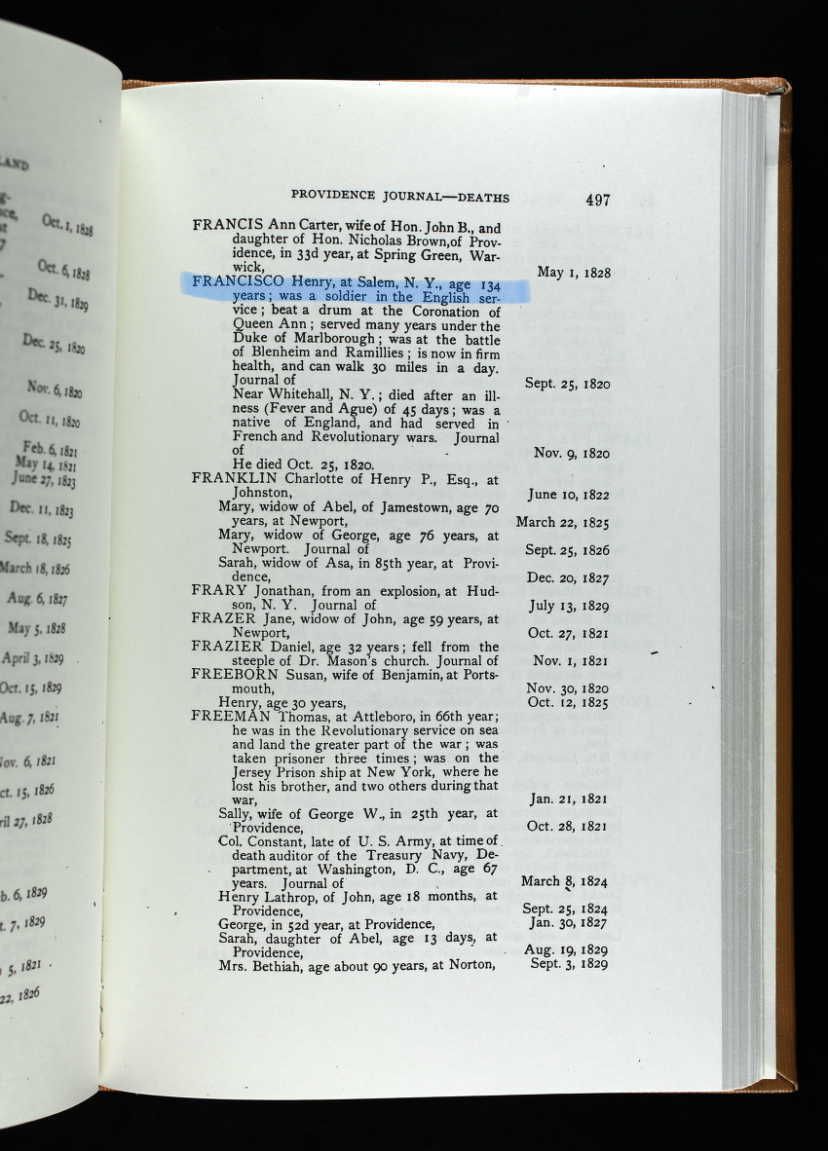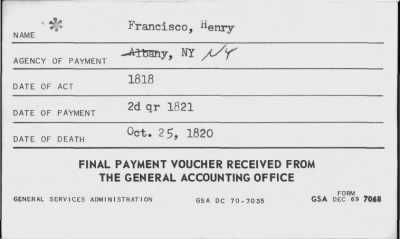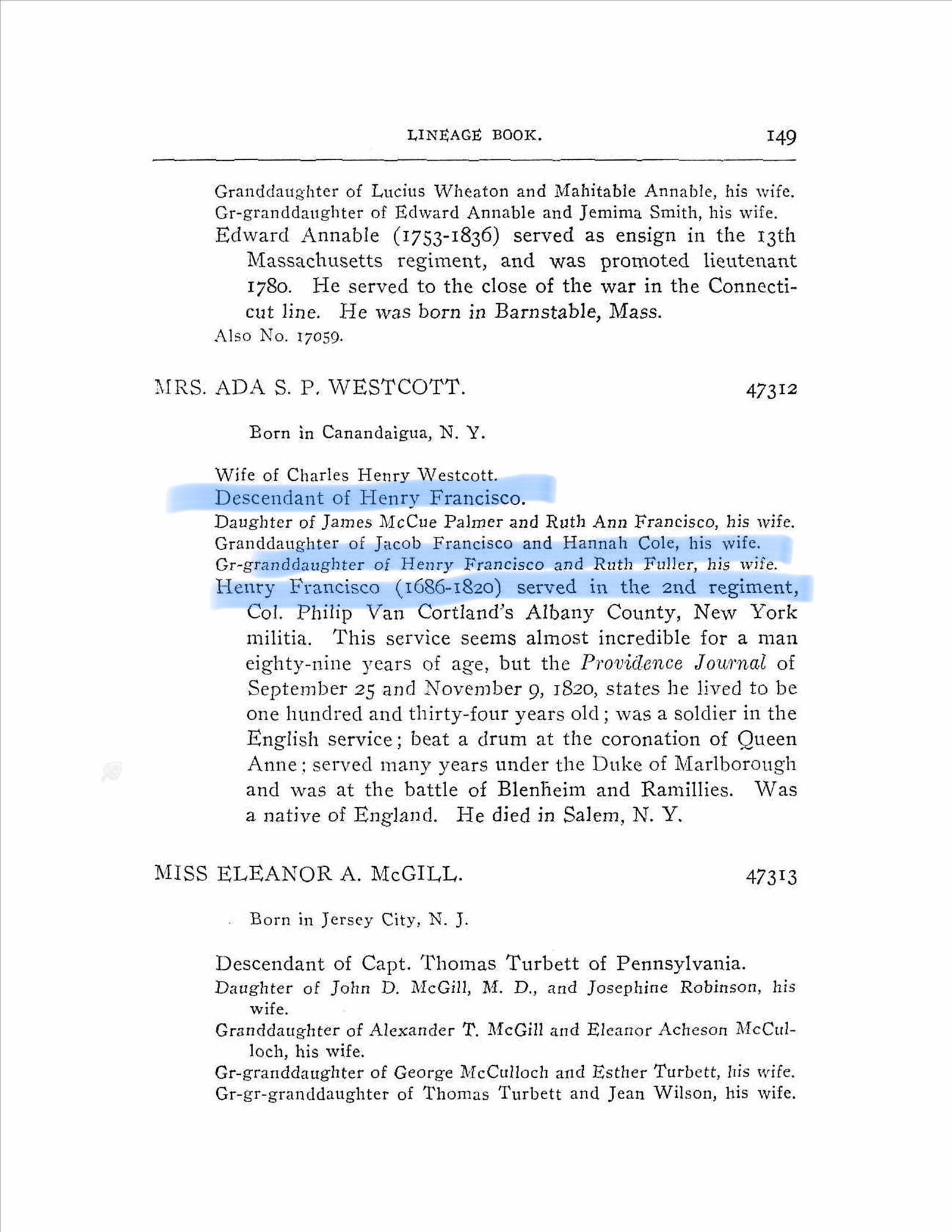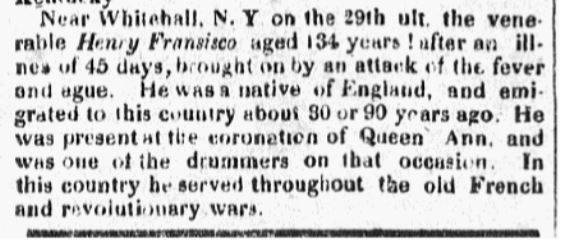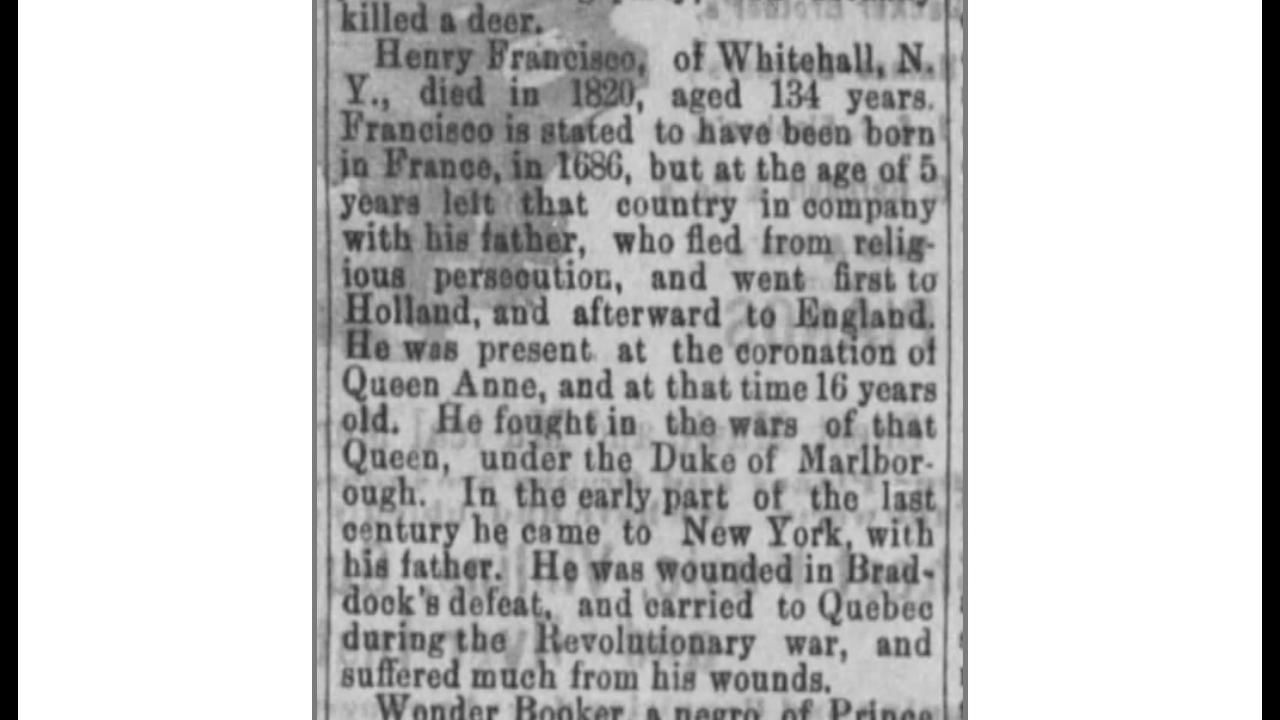Possibly one of the oldest men on record in the past 300 years, he was estimated to have been 134 years old at the time of his death.
Born in a small village in France to a Huguenot father and a Dutch mother, his family soon moved to England to escape religious persecution from King Louis XIV. In April 1702, as a 16 year old drummer boy in the English Army, he played at the St. George's Day coronation of Queen Anne in London, and later participated in several of the British-French battles, including the Battle of Blenheim in 1704, during the War of the Spanish Succession, and later, at the Battle of Ramilles, Belgium in 1706. Following that war, he decided to move to the colony of New York, where he settled on a farm near Whitehall. In 1754, he rejoined the British Army for the Seven Years War (called the French and Indian War, in the US) and reportedly was at Braddock's Defeat the next year, where he was wounded. But it was in January 1777, after the American Revolution had broken out, that he again joined up at the age of 91, into the Continental Army, to serve as a Private in Captain Jeremiah Burrough's Company, a part of the Green Mountain Boys. He would later complain that while he was away in the Continental Army, Tories burned down his house and barn. His unit saw action during the Battle of Saratoga, against the British Army of Major General John Burgoyne, and again in heavy fighting at the battles of Hubbardton, Bennington, Freeman's Farm, and Bemis Heights. In an interview later in his life, Francisco states that he was captured at Hubbardton, and taken with other prisoners to Quebec, although there is no record of names of the American prisoners who were taken to Quebec. He was discharged for medical reasons on April 20, 1778, by a Doctor Washburn; the doctor wrote that Francisco was lame and unfit for further duty. Following his release, Francisco returned to his home in Whitehall, NY, where he resumed his farming. He is listed in the 1790 census as living in the home of his daughter Ruth Wilson and her husband, Robert. Most records of his life in New York were destroyed in an 1860 fire of the County Clerk's Office. In 1818, Francisco applied for a pension, during which he stated that he was upwards of 134 years old and unable to work, except to assist his wife, a weaver. Owning very little property, other than a cow and a weaving loom (total value about $18), the pension was granted. In October 1819, he was interviewed by Yale scholar Benjamin Stillman, who reported him hearty and hale, despite his advanced old age, and assisting his wife, then in her 80s, with her weaving. Stillman's interview was published in his book, "Remarks Made on a Short Tour Between Hartford and Quebec, in the Autumn of 1819." Stillman described Francisco as having a "bright expression, cheerful and intelligent, his features are handsome…regular and wonderfully undisfigured by the hand of time." He was reported as walking "with less inconvience than most people exhibit at 85 or 90 years, yet he stoops but little, even when unsupported." His wife was reported as equally well, weaving six yards a day at her loom, at which Francisco supplied her with more yarn than she could weave. Francisco died the year after the interview, in October 1820, following an illness of 45 days, believed to be malaria. It was recorded that he was buried in the Old Skene Cemetery, which has now been lost, and the cemetery location and his grave remains undiscovered. (Bio by Kit and Morgan Benson)
Possibly one of the oldest men on record in the past 300 years, he was estimated to have been 134 years old at the time of his death.
Born in a small village in France to a Huguenot father and a Dutch mother, his family soon moved to England to escape religious persecution from King Louis XIV. In April 1702, as a 16 year old drummer boy in the English Army, he played at the St. George's Day coronation of Queen Anne in London, and later participated in several of the British-French battles, including the Battle of Blenheim in 1704, during the War of the Spanish Succession, and later, at the Battle of Ramilles, Belgium in 1706. Following that war, he decided to move to the colony of New York, where he settled on a farm near Whitehall. In 1754, he rejoined the British Army for the Seven Years War (called the French and Indian War, in the US) and reportedly was at Braddock's Defeat the next year, where he was wounded. But it was in January 1777, after the American Revolution had broken out, that he again joined up at the age of 91, into the Continental Army, to serve as a Private in Captain Jeremiah Burrough's Company, a part of the Green Mountain Boys. He would later complain that while he was away in the Continental Army, Tories burned down his house and barn. His unit saw action during the Battle of Saratoga, against the British Army of Major General John Burgoyne, and again in heavy fighting at the battles of Hubbardton, Bennington, Freeman's Farm, and Bemis Heights. In an interview later in his life, Francisco states that he was captured at Hubbardton, and taken with other prisoners to Quebec, although there is no record of names of the American prisoners who were taken to Quebec. He was discharged for medical reasons on April 20, 1778, by a Doctor Washburn; the doctor wrote that Francisco was lame and unfit for further duty. Following his release, Francisco returned to his home in Whitehall, NY, where he resumed his farming. He is listed in the 1790 census as living in the home of his daughter Ruth Wilson and her husband, Robert. Most records of his life in New York were destroyed in an 1860 fire of the County Clerk's Office. In 1818, Francisco applied for a pension, during which he stated that he was upwards of 134 years old and unable to work, except to assist his wife, a weaver. Owning very little property, other than a cow and a weaving loom (total value about $18), the pension was granted. In October 1819, he was interviewed by Yale scholar Benjamin Stillman, who reported him hearty and hale, despite his advanced old age, and assisting his wife, then in her 80s, with her weaving. Stillman's interview was published in his book, "Remarks Made on a Short Tour Between Hartford and Quebec, in the Autumn of 1819." Stillman described Francisco as having a "bright expression, cheerful and intelligent, his features are handsome…regular and wonderfully undisfigured by the hand of time." He was reported as walking "with less inconvience than most people exhibit at 85 or 90 years, yet he stoops but little, even when unsupported." His wife was reported as equally well, weaving six yards a day at her loom, at which Francisco supplied her with more yarn than she could weave. Francisco died the year after the interview, in October 1820, following an illness of 45 days, believed to be malaria. It was recorded that he was buried in the Old Skene Cemetery, which has now been lost, and the cemetery location and his grave remains undiscovered. (Bio by Kit and Morgan Benson)






